
The New York Times (NYT) is an American daily newspaper based in New York City. The New York Times covers domestic, national, and international news, and publishes opinion pieces, investigative reports, and reviews. As one of the longest-running newspapers in the United States, it serves as one of the country's newspapers of record. As of May 2024, the newspaper has a readership of 9.9 million digital-only subscribers and 640,000 print subscribers, making it the second-largest newspaper in the country by print circulation. The Times has received 137 Pulitzer Prizes as of 2023, the most of any publication, among other accolades. The New York Times is published by The New York Times Company; since 1896, the company has been chaired by the Ochs-Sulzberger family, including its current chairman and the paper's publisher, A. G. Sulzberger. The Times is headquartered at The New York Times Building in Manhattan.

The New York Times Company is an American mass-media company that publishes The New York Times, its associated publications, and other media properties. Its headquarters are in Manhattan, New York City.
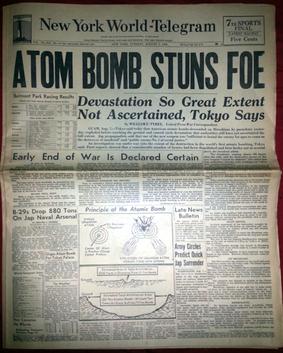
The New York World-Telegram, later known as the New York World-Telegram and The Sun, was a New York City newspaper from 1931 to 1966.

The New York Herald was a large-distribution newspaper based in New York City that existed between 1835 and 1924. At that point it was acquired by its smaller rival the New-York Tribune to form the New York Herald Tribune.
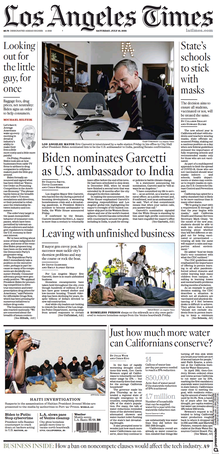
The Los Angeles Times is a regional American daily newspaper that started publishing in Los Angeles, California in 1881. Based in the Greater Los Angeles area city of El Segundo since 2018, it is the sixth-largest newspaper by circulation in the United States, as well as the largest newspaper in the western United States. Owned by Patrick Soon-Shiong and published by California Times, the paper has won more than 40 Pulitzer Prizes.

The New York Herald Tribune was a newspaper published between 1924 and 1966. It was created in 1924 when Ogden Mills Reid of the New York Tribune acquired the New York Herald. It was regarded as a "writer's newspaper" and competed with The New York Times in the daily morning market. The paper won twelve Pulitzer Prizes during its lifetime.

The Sun was a New York newspaper published from 1833 until 1950. It was considered a serious paper, like the city's two more successful broadsheets, The New York Times and the New York Herald Tribune. The Sun was the first successful penny daily newspaper in the United States, and was for a time, the most successful newspaper in America.
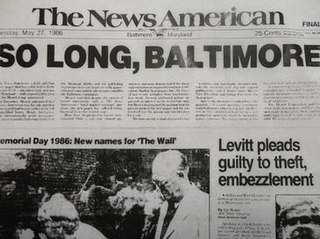
The Baltimore News-American was a broadsheet newspaper published in downtown Baltimore, Maryland until May 27, 1986. It had a continuous lineage of more than 200 years. For much of the mid-20th century, it had the largest circulation in the city.

The Washington Times-Herald (1939–1954) was an American daily newspaper published in Washington, D.C. It was created by Eleanor "Cissy" Patterson of the Medill–McCormick–Patterson family when she bought The Washington Times and The Washington Herald from the syndicate newspaper publisher William Randolph Hearst (1863–1951), and merged them. The result was a "24-hour" newspaper, with 10 editions per day, from morning to evening.

Frank Andrew Munsey was an American newspaper and magazine publisher, banker, political financier and author. He was born in Mercer, Maine, but spent most of his life in New York City. The village of Munsey Park, New York, is named for him, along with The Munsey Building in downtown Baltimore, Maryland, at the southeast corner of North Calvert and East Fayette Streets.
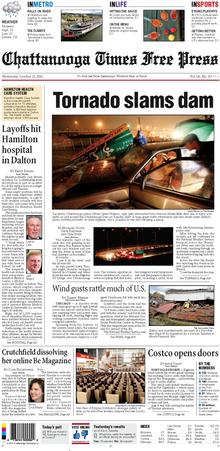
The Chattanooga Times Free Press is a daily broadsheet newspaper published in Chattanooga, Tennessee, and is distributed in the metropolitan Chattanooga region of southeastern Tennessee and northwestern Georgia. It is one of Tennessee's major newspapers and is owned by WEHCO Media, Inc., a diversified communications company with ownership in 14 daily newspapers, 11 weekly newspapers and 13 cable television companies in six states.
James Oliver Goldsborough (1936-2023) was an American journalist and author, born in New York City of a family with roots in Pittsburgh. Brought up in Los Angeles, he graduated from UCLA with a degree in economics. After serving two years in the U.S. Army he attended UC Berkeley Law School and Mexico City College.
Southern Newspapers Inc. (SNI) is a publishing holding company headquartered in Houston, Texas. The company was founded as Southern Newspapers, Inc., of Tennessee in 1967 by Carmage Walls. Its flagship paper, the Galveston County Daily News is the oldest newspaper in Texas, founded in 1842.

Perfil is an Argentine weekly tabloid based in Buenos Aires and refounded in 2005.
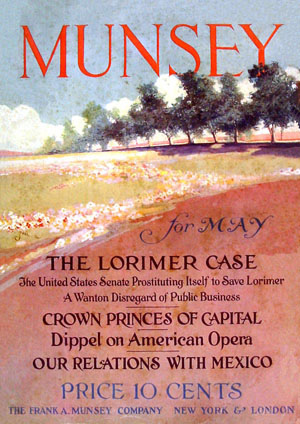
Munsey's Magazine was an American magazine founded by Frank Munsey. Originally launched in 1889 as Munsey's Weekly, a humorous magazine, edited by John Kendrick Bangs, it was not successful, and by late 1891 had lost $100,000. Munsey converted it to a general illustrated monthly in October of that year, retitled Munsey's Magazine and priced at twenty-five cents. Richard Titherington became the editor, and remained in that role for the rest of the magazine's existence. In 1893 Munsey reduced the price to ten cents : this brought him into conflict with the American News Company, which had a near-monopoly on magazine distribution, as they were unwilling to handle the magazine at the cost Munsey asked for. Munsey started his own distribution company and was quickly successful: the first issue at ten cents began with a print run of 20,000 copies but eventually sold 60,000, and within a year circulation had risen to over a quarter of a million issues.
The Killeen Daily Herald is a daily newspaper in Killeen, Texas. The newspaper is owned by Frank Mayborn Enterprises, Inc.

The International Herald Tribune (IHT) was a daily English-language newspaper published in Paris, France for international English-speaking readers. It had the aim of becoming "the world's first global newspaper" and could fairly be said to have met that goal. It published under the name International Herald Tribune starting in 1967, but its origins as an international newspaper trace back to 1887. Sold in over 160 countries, the International Herald Tribune was an innovative newspaper that continued to produce a large amount of unique content until its closure in 2013.

Walter Boardman Kerr was an American journalist, publisher and book author.
Following World War II, The New York Times continued to expand. The Times was subject to investigations from the Senate Internal Security Subcommittee, a McCarthyist subcommittee that investigated purported communism from within press institutions. Arthur Hays Sulzberger's decision to dismiss a copyreader who plead the Fifth Amendment drew ire from within the Times and from external organizations. In April 1961, Sulzberger resigned, appointing his son-in-law, The New York Times Company president Orvil Dryfoos. Under Dryfoos, The New York Times established a newspaper based in Los Angeles. In 1962, the implementation of automated printing presses in response to increasing costs mounted fears over technological unemployment. The New York Typographical Union staged a strike in December, altering the media consumption of New Yorkers. The strike left New York with three remaining newspapers—the Times, the Daily News, and the New York Post—by its conclusion in March 1963. In May, Dryfoos died of a heart ailment. Following weeks of ambiguity, Arthur Ochs Sulzberger became The New York Times's publisher.
In August 1896, Chattanooga Times publisher Adolph Ochs acquired The New-York Times, implementing significant alterations to the newspaper's structure. Ochs established the Times as a merchant's newspaper and removed the hyphen from the newspaper's name. In 1905, The New York Times opened Times Tower, marking expansion. The Times experienced a political realignment in the 1910s amid several disagreements within the Republican Party. The New York Times reported on the sinking of the Titanic as other newspapers were cautious about bulletins from the Associated Press. Through managing editor Carr Van Anda, the Times focused on scientific advancements, reporting on Albert Einstein's then-unknown theory of general relativity and becoming involved in the discovery of the tomb of Tutankhamun. In April 1935, Ochs died, leaving his son-in-law Arthur Hays Sulzberger as publisher. The Great Depression forced Sulzberger to reduce The New York Times's operations, and developments in the New York newspaper landscape resulted in the formation of larger newspapers, such as the New York Herald Tribune and the New York World-Telegram. In contrast to Ochs, Sulzberger encouraged wirephotography.

















